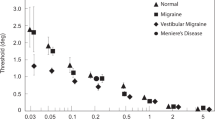Abstract
Even though dizziness is a common symptom of heat illness, comprehensive evaluation of the vestibular function has not been available in this potentially life-threatening disorder. Three patients developed vertigo about a week after heat exposure. Evaluation showed bilateral impairments of the vestibulo-ocular reflex during head impulses and the signs of vestibulocerebellar dysfunction that included spontaneous downbeat nystagmus, gaze-evoked nystagmus, and positional downbeat nystagmus. Exposure to excessive heat may give rise to delayed vestibulopathy by damaging the vestibulocerebellum.


Similar content being viewed by others
References
Bouchama A, Knochel JP (2002) Heat stroke. N Engl J Med 346:1978–1988
Becker JA, Stewart LK (2011) Heat-related illness. Am Fam Physician 83:1325–1330
Bazille C, Megarbane B, Bensimhon D, Lavergne-Slove A, Baglin AC, Loirat P, Woimant F, Mikol J, Gray F (2005) Brain damage after heat stroke. J Neuropathol Exp Neurol 64:970–975
Morimoto RI, Kroeger PE, Cotto JJ (1996) The transcriptional regulation of heat shock genes: a plethora of heat shock factors and regulatory conditions. EXS 77:139–163
Wang ZZ, Wang CL, Wu TC, Pan HN, Wang SK, Jiang JD (2001) Autoantibody response to heat shock protein 70 in patients with heatstroke. Am J Med 111:654–657
Yamada PM, Amorim FT, Moseley P, Robergs R, Schneider SM (2007) Effect of heat acclimation on heat shock protein 72 and interleukin-10 in humans. J Appl Physiol 103:1196–1204
Mehta AC, Baker RN (1970) Persistent neurological deficits in heat stroke. Neurology 20:336–340
Albukrek D, Bakon M, Moran DS, Faibel M, Epstein Y (1997) Heat-stroke-induced cerebellar atrophy: clinical course, CT and MRI findings. Neuroradiology 39:195–197
Yee RD (1989) Downbeat nystagmus: characteristics and localization of lesions. Trans Am Ophthalmol Soc 87:984–1032
Huh YE, Kim JS, Kim HJ, Park SH, Jeon BS, Kim JM, Cho JW, Zee DS (2015) Vestibular performance during high-acceleration stimuli correlates with clinical decline in SCA6. Cerebellum 14:284–291
Park HK, Kim JS, Strupp M, Zee DS (2013) Isolated floccular infarction: impaired vestibular responses to horizontal head impulse. J Neurol 260:1576–1582
Lee SU, Park SH, Park JJ, Kim HJ, Han MK, Bae HJ, Kim JS (2015) Dorsal medullary infarction: distinct syndrome of isolated central vestibulopathy. Stroke 46:3081–3087
Walker MF, Zee DS (2005) Asymmetry of the pitch vestibulo-ocular reflex in patients with cerebellar disease. Ann N Y Acad Sci 1039:349–358
Deleu D, El Siddig A, Kamran S, Kamha AA, Al Omary IY, Zalabany HA (2005) Downbeat nystagmus following classical heat stroke. Clin Neurol Neurosurg 108:102–104
Jeong SH, Kim JS, Baek IC, Shin JW, Jo H, Lee AY, Kim JM (2013) Perverted head impulse test in cerebellar ataxia. Cerebellum 12:773–775
Manto MU (1996) Isolated cerebellar dysarthria associated with a heat stroke. Clin Neurol Neurosurg 98:55–56
Edwards MJ (1998) Apoptosis, the heat shock response, hyperthermia, birth defects, disease and cancer. Where are the common links? Cell Stress Chaperones 3:213–220
Germain MA, Webster WS, Edwards MJ (1985) Hyperthermia as a teratogen: parameters determining hyperthermia-induced head defects in the rat. Teratology 31:265–272
Chambers CA, Hopkins RO, Weaver LK, Key C (2008) Cognitive and affective outcomes of more severe compared to less severe carbon monoxide poisoning. Brain Inj 22:387–395
Oh S, Choi SC (2015) Acute carbon monoxide poisoning and delayed neurological sequelae: a potential neuroprotection bundle therapy. Neural Regen Res 10:36–38
Bauer I, Pannen BH (2009) Bench-to-bedside review: carbon monoxide–from mitochondrial poisoning to therapeutic use. Crit Care 13:220
Allagui MS, Vincent C, El feki A, Gaubin Y, Croute F (2007) Lithium toxicity and expression of stress-related genes or proteins in A549 cells. Biochim Biophys Acta 1773:1107–1115
Acknowledgments
This study was supported by a grant of the Korea Healthcare Technology R&D Project, Ministry of Health and Welfare, Republic of Korea (HI10C2020).
Author information
Authors and Affiliations
Corresponding author
Ethics declarations
Study ethics
All experiments followed the tenets of the Declaration of Helsinki and this study was approved by the Institutional Review Board of Seoul National University Bundang Hospital (B-B-1603-338-701).
Conflicts of interest
No conflicting relationship exists for the authors.
Disclosures
Drs. Jung, Choi, and H Kim report no disclosure. Dr. Ji-Soo Kim serves as an associate editor of Frontiers in Neuro-otology and on the editorial boards of the Journal of Korean Society of Clinical Neurophysiology, Journal of Clinical Neurology, Frontiers in Neuro-ophthalmology, Journal of Neuro-ophthalmology, Journal of Vestibular Research, Journal of Neurology, and Medicine.
Additional information
I. Jung and S.-Y. Choi equally contributed to this study.
Electronic supplementary material
Below is the link to the electronic supplementary material.
Supplementary material 1 Video 1 Ocular motor findings and ataxia in patient 1. Video shows spontaneous downbeat nystagmus and direction-changing horizontal gaze-evoked nystagmus with a side-pocket-like appearance during lateral gazes. HITs show corrective catch-up saccades during stimulation of horizontal and posterior semicircular canals on both sides with a perverted downward component when stimulating the horizontal canals. Truncal and limb ataxia are also evident (WMV 69513 kb)
Supplementary material 2 Video 2 Horizontal and vertical head impulse tests in patient 2. Video shows horizontal gaze-evoked nystagmus and corrective catch-up saccades during head impulse stimulation of the horizontal and posterior semicircular canals on both sides. Downward corrective saccades are prominent during stimulation of the horizontal canals (WMV 45950 kb)
Rights and permissions
About this article
Cite this article
Jung, I., Choi, SY., Kim, HJ. et al. Delayed vestibulopathy after heat exposure. J Neurol 264, 49–53 (2017). https://doi.org/10.1007/s00415-016-8322-x
Received:
Revised:
Accepted:
Published:
Issue Date:
DOI: https://doi.org/10.1007/s00415-016-8322-x




